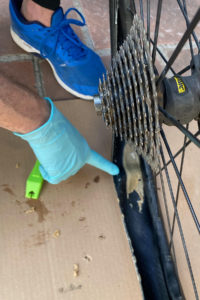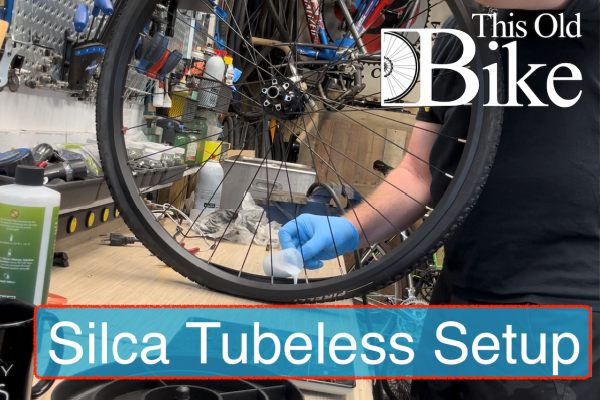
Diet And Weight Loss To Make You Faster
Nutrition and food choices are a key component of weight loss for all endurance athletes, including cyclists. When done correctly, weight loss can have a huge
By: A.V. Schmit
 That’s right, if you ride tubeless, there could be a sealant monster lurking in your tires. If you haven’t ridden your gravel or mountain bike since the autumn, and you haven’t spun your wheels since then, chances are there is a big glob of sealant that has cured inside your tires.
That’s right, if you ride tubeless, there could be a sealant monster lurking in your tires. If you haven’t ridden your gravel or mountain bike since the autumn, and you haven’t spun your wheels since then, chances are there is a big glob of sealant that has cured inside your tires.
“Oh, it’s Spring, I should add some sealant to my tubeless tires just to be on the safe side,” said the average cyclist riding tubeless tires.
Nope, that’s not gonna do it. The addition of new sealant is not going to kill the dreaded sealant monster. It’s still inside the tire, lurking, waiting, plotting to leave you stranded by the side of the road or trail.
Let’s take a minute to understand how tubeless tires work and what role sealant plays. As a general rule, “tubeless” refers to a system that consists of: a tubeless compatible rim and tire, rim tape and sealant. They all work together to keep the tire on the wheel, air in the tire, and punctures from “flatting” the tire.
All currently available tubeless tires require sealant. The sealant completes the tire system by preventing air from escaping through the pores and small imperfections in the tire. The adhesive-backed rim tape prevents air from escaping through the spoke holes of the rim. Sealant also provides a level of puncture protection by using the tire’s internal air pressure to force sealant through small punctures when they occur.
 A word about sealant. Most sealants are made of natural or synthetic latex and contain cellulose, rubber particles or organic thickeners and glycol which acts as a liquid carrier for the suspended particles. Most are highly basic, not as in simple, but as in the opposite of acidic on the Ph scale.
A word about sealant. Most sealants are made of natural or synthetic latex and contain cellulose, rubber particles or organic thickeners and glycol which acts as a liquid carrier for the suspended particles. Most are highly basic, not as in simple, but as in the opposite of acidic on the Ph scale.
When the tire is punctured, the internal air pressure of the tire forces the liquid sealant in through the hole, and a small amount escapes. When this happens the fibers or small particles build-up at the site of the puncture and intertwine to form a flexible plug. Then a chemical reaction happens that “cures” the rubber and fills the puncture. But sealant doesn’t last forever.
“Sealant should last an average of 2-6 months depending on factors such as: temperatures and humidity in your area, how often you ride, where you store your bike (cooler is better), tire casing thickness, number of punctures the sealant has already sealed that you never knew you had, etc.” — Stan’s No-Tubes
And that curing process is what creates sealant monsters over the winter. When a rush of air pressure from the tire forces it’s way to the site of the puncture, it accelerates the reaction.

Over time, the reaction happens at a much slower rate that slowly cures the sealant into the dreaded sealant monster.
A cured section of sealant, AKA a sealant monster, reduces the amount of liquid sealant in the tire available to seal a puncture. It creates an area where even additional sealant when added to the tire after it forms will not be able to fill a puncture. It also puts the wheel / tire completely out of balance, like when your car loses a wheel weight.
The moral of this fairy tale… If it has been more than a few months since you’ve ridden your tubeless tire equipped bike, it’s probably a good idea to see your mechanic and have them banish the dreaded sealant monster for the season.


Nutrition and food choices are a key component of weight loss for all endurance athletes, including cyclists. When done correctly, weight loss can have a huge

Photos are rolling from Mt. Blue Sky/Bob Cook Memorial Hill Climb p/b Team Evergreen on that was held this past weekend. The day lived up

Pad Thai is a popular street food in Thailand, which is whipped up quickly and packed full of flavor. It’s one of our favorite post-ride

Tubless Tires: Myth or Magic? Justin Bolinger of I Know a Guy Bicycles “UNBOXES” the Truth about this setup (Should you go Tubeless?) Recent Posts

Last week, Douglas County hosted the Natural Grocers Criterium at their sheriff’s training facility, and the camera of Ryan Muncy/Ryan Muncy Photography was on the scene

When you are looking to refuel at lunchtime, go for carbs and quality protein – this pasta dish is ideal. Cycling takes energy, and energy come